Cucumbers are the favorite vegetable crop of the Pumpkin family, which people gladly grow in their gardens and greenhouses. Crispy and juicy cucumbers tightly entered the daily diet of a person, becoming an integral part of many dishes.
Weather conditions do not always allow you to grow a good crop, which is why gardeners prefer to grow seedlings in advance and plant them in a greenhouse to harvest cucumbers for as long as possible.
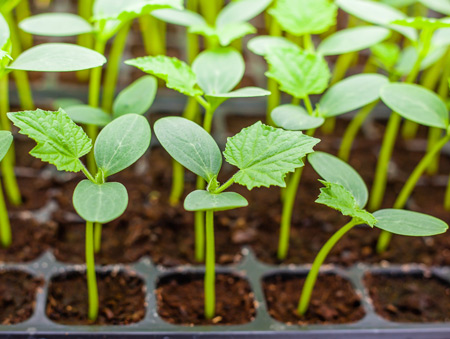
Growing vegetables in greenhouse conditions is quite simple, even a novice grower can do this job. Properly planted at home, cucumber seedlings designed for the greenhouse will help to grow strong and healthy plants with juicy fruits without much effort. The main thing is to choose high-quality seeds and find out the timing of their sowing in a specific region of the country.
Content
Goals and the need for planting cucumber seeds for seedlings
Vegetable seeds are characterized by good germination and germinate fairly quickly even when sown directly in the ground. Therefore, many vegetable growers do not want to spend their time and energy on germinating cucumber seedlings in the room. However, it should be borne in mind that this method of growing has a number of its drawbacks, which can be avoided previously by germinating the seeds of the vegetable at home.
Thus, while on a plant whose seeds were sown in the soil, only fruits are tied, it is already possible to harvest crops from cucumbers obtained by the seedling method. It is the ability to harvest as early as possible is the main goal of vegetable growers, who prefer the seedling method of growing cucumbers. In addition, early fruit setting helps protect them from the harmful effects of too hot and dry periods, which usually occur in mid-summer.
Transplanting seedlings into the soil, you can correctly distribute the territory of the greenhouse, and avoid too dense or sparse planting of bushes, which quite often happens when sowing seeds on the bed.
Methods for growing cucumber seedlings at home for a greenhouse
There are several ways to grow cucumber seedlings, so each grower will be able to choose the most convenient and simple option. The main thing is to avoid sowing seeds in a common container, because otherwise seedlings will have to be dived, and tender young cucumber stalks rarely survive this procedure.
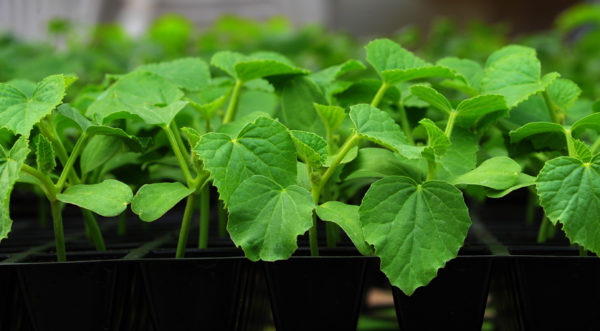 You may be interested in:
You may be interested in:In peat tablets and pots
Pills or pots of peat are perfect for sowing seeds. It is better for inexperienced growers to give preference to just such a method of germinating seeds, since seedlings can be transplanted into the ground together with such a container. This will keep the root system of the young plant intact, and significantly reduce the period of adaptation of the bush to a new place of growth.
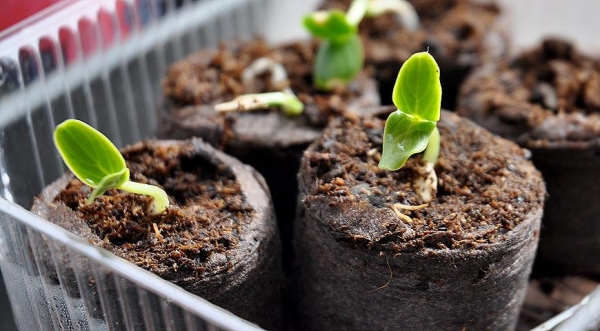
Before you start sowing seeds in tablets, the latter must be installed in a common container with high walls and pour water for swelling. One cucumber seed is placed in each swollen tablet; a similar rule applies to peat pots. After placing the seeds in containers, they must be covered with a plastic bottle or polyethylene. However, it should be borne in mind that glasses of peat dry out quite quickly, which must be remembered when caring for seedlings.
In plastic cups
You can also sow the seeds of culture in plastic cups or cut plastic bottles with a diameter of at least 10 cm. To do this, the bottom of the tank must be equipped with drainage holes that will prevent stagnation of moisture in the soil.
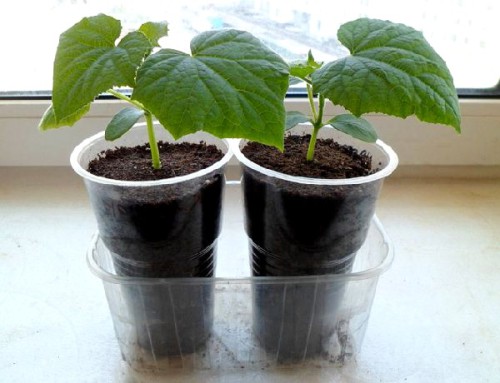
After the glass is processed and equipped with drainage, it must be filled with a soil mixture consisting of peat, humus, turf and sand, taken in a ratio of 2: 2: 1: 0.5. Seeds are immersed in the ground to a depth of 1.5-2 cm and lightly sprinkled with earth. To create greenhouse conditions, the container with seeds must be covered with plastic wrap.
In the eggshell
Well-dried egg shells can be used as a container for germinating cucumber seeds. Before starting to sow planting material, pierce the bottom of the shell several times.
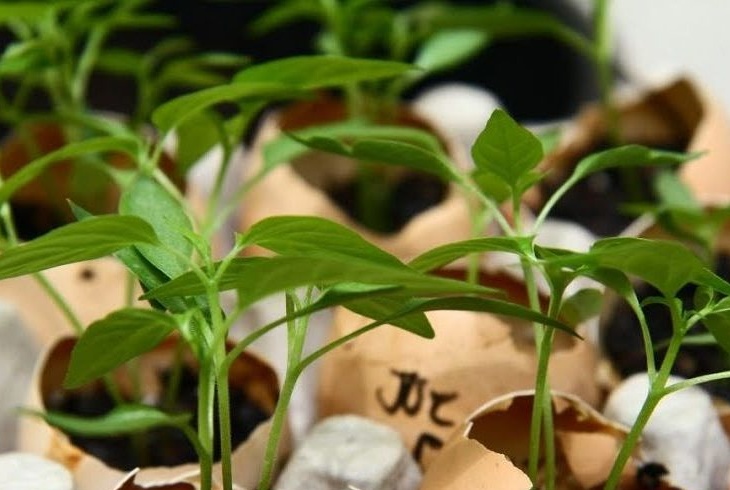
The shell is placed in containers and filled with nutrient soil to exactly half. Next, in each cup you need to place one seed, and sprinkle them on top of the ground. After sowing, the shell is covered with plastic wrap or plastic to reduce the rate of evaporation of moisture from the soil surface.
In sawdust
Growing seeds in sawdust is a fairly new, but win-win method to get a healthy plant. Sawdust can be purchased at the pet store, they are usually sold under the name "Universal bedding for small pets."
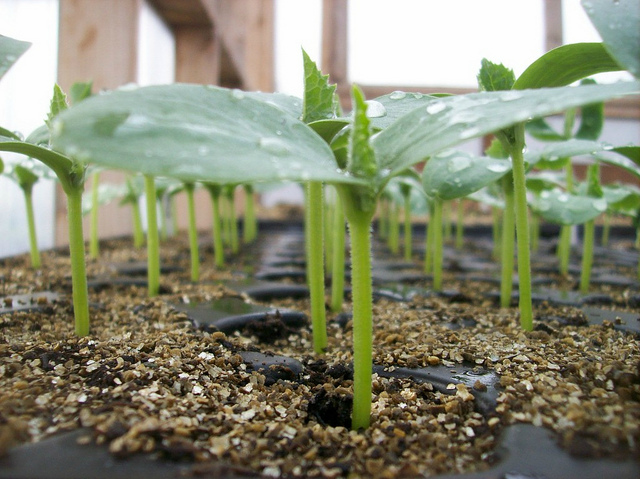
The cells on ¼ are filled with sawdust, which must be filled with hot water to swell. Immediately after pouring water, the sawdust must be crushed by hand to the state of crumbs. Knead the sawdust as quickly as possible, because they cool quickly enough. Seeds are immersed in a hole 1-1.5 cm deep and covered with sawdust. The container must be covered with polyethylene or a plastic lid.
Seedling Growth Algorithm
Compliance with all the rules of agricultural technology during sowing and germination of seeds will allow you to get a healthy cucumber bush in the future.
Seed and soil preparation
Planting material and soil need additional preparation. In the case of using ordinary seeds, they must be sorted, immersed in salted water. Under the influence of salt water, unsuitable material will float, and good material will sink to the bottom.After all healthy seeds are selected, they must be washed, dried and subjected to additional processing.
Stages of processing conventional seeds:
- Immerse for 30 minutes in a concentrated solution of potassium permanganate.
- Dry and place them in the ash solution for 10-12 hours. The solution is prepared in a proportion of 2 tbsp. l wood ash per 1 liter of water.
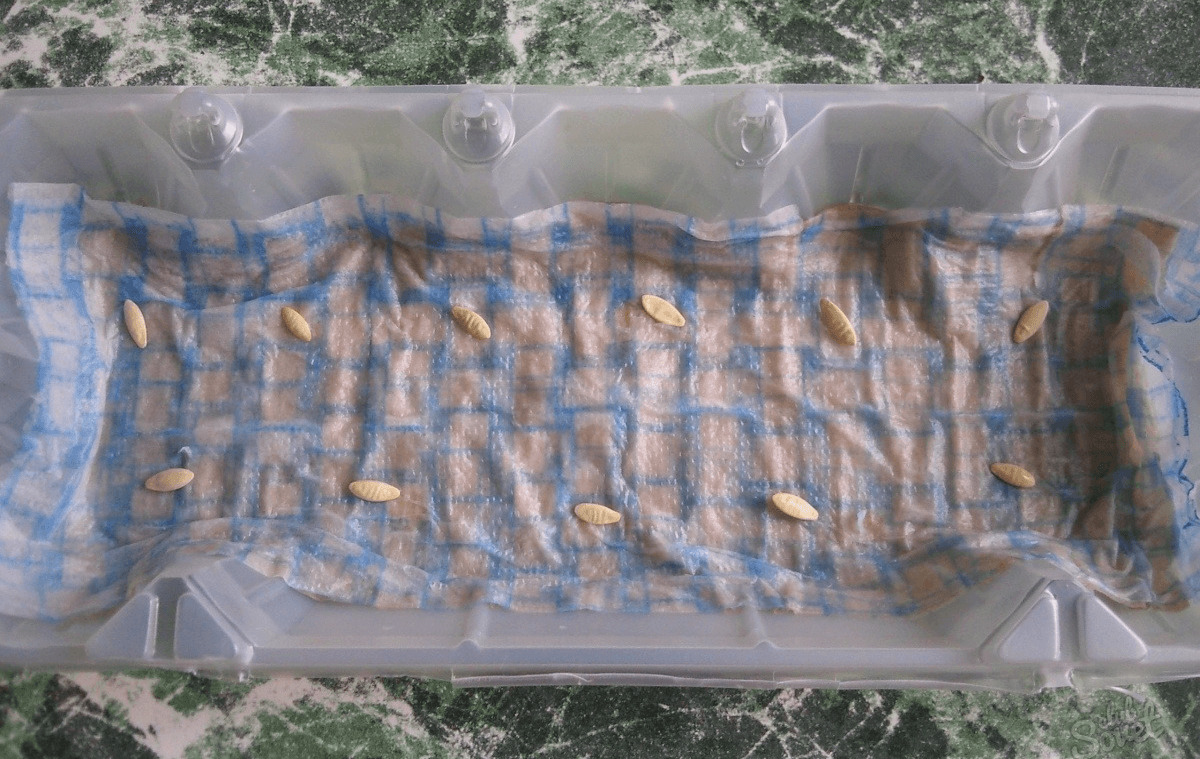
Seed treatment - Wrap the planting material with wet gauze, and place the seeds in a warm place for several days.
- If necessary, moisten the gauze until it germinates.
As soon as the seeds hatch, you can begin to sow them, they do not need additional preparation.
For sowing, you can use either purchased soil for cucumbers, or mixed personally from turf, humus and peat, taken in equal quantities, and 1 tbsp. wood ash. In the soil mixture it is also necessary to introduce complex mineral fertilizers for vegetables, in the proportion of 1 tbsp. l fertilizers on a 10 liter water bucket. It is recommended to decontaminate the mixed soil before use by scalding with hot water.
Rules for caring for young plants
Young plants must be kept in a warm and well-lit place. A container with seeds that have not yet pecked must be kept under a plastic film at a temperature of 25-27 °. After the appearance of the first shoots, the “cover” is removed, and containers with young plants are transferred to a cool but well-lit place for several days.
The temperature in the room should be between 15-20 °. To provide seedlings with a sufficient amount of light, you can use special phytolamps. Subsequently, the plants are kept at room temperature, up to planting in the ground.
A few days before planting in the soil, the plant must be fed with complex mineral fertilizers for vegetable crops, using approximately half a glass of liquid fertilizer for each bush.
Features of growing seedlings in different regions
Before proceeding growing cucumbers, it is recommended that the optimal timing of planting material and planting seedlings in the greenhouse be determined as accurately as possible. When determining the appropriate sowing time, it is necessary to take into account the climatic conditions of the region in which the plant will be grown.
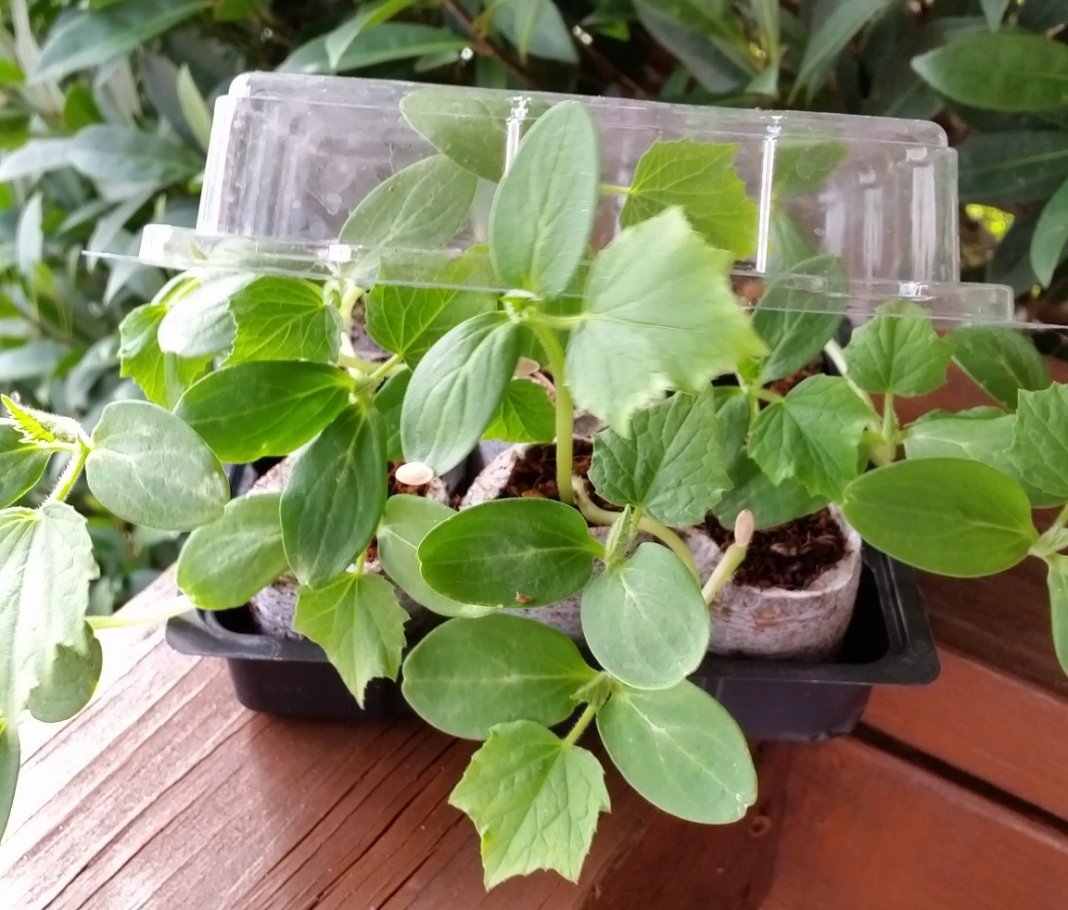
Planting seedlings on the beds is possible only after the air in the greenhouse warms up to 18 °, and the soil to 10-12 °. Since the seedlings become suitable for transplanting into the soil only 3-4 weeks after sowing, this is the period that should be counted from the estimated date of planting the bush for a permanent habitat.
In the middle lane and in the suburbs
The climatic conditions in the suburbs are excellent for growing cucumbers both in open ground and in a greenhouse. Suitable weather for planting seedlings in the greenhouse here, as a rule, occurs in the middle or late May, depending on how long the winter was. In this regard, it is recommended to start sowing cucumber seeds after April 15.
In the Urals and Northern Regions
Growing cucumbers in the Urals and other northern regions, it is worth giving preference to frost-resistant plant varieties. The northern regions of the country are distinguished by especially cold nights, therefore it is better to water the beds with cucumbers at noon, completely avoiding evening watering.It is better to start sowing seeds at the end of April or beginning of May, so that by the first days of June (just by this month the soil warms up enough) the plant was ready for transplanting into the ground.
South of Russia
In the southern regions, sowing cucumbers for seedlings can begin already in the second half of March. This will allow plants to be planted in greenhouse soil already in mid-April, since in these regions the earth by this time is usually quite warm.
What to do if leaves wither and turn yellow on cucumber seedlings
Improper seed preparation for planting or poor seedling care can cause cucumber bush soreness. Quite often, in response to improper care, the leaves turn yellow on the bush, and many gardeners do not understand what to do in order to eliminate this problem.
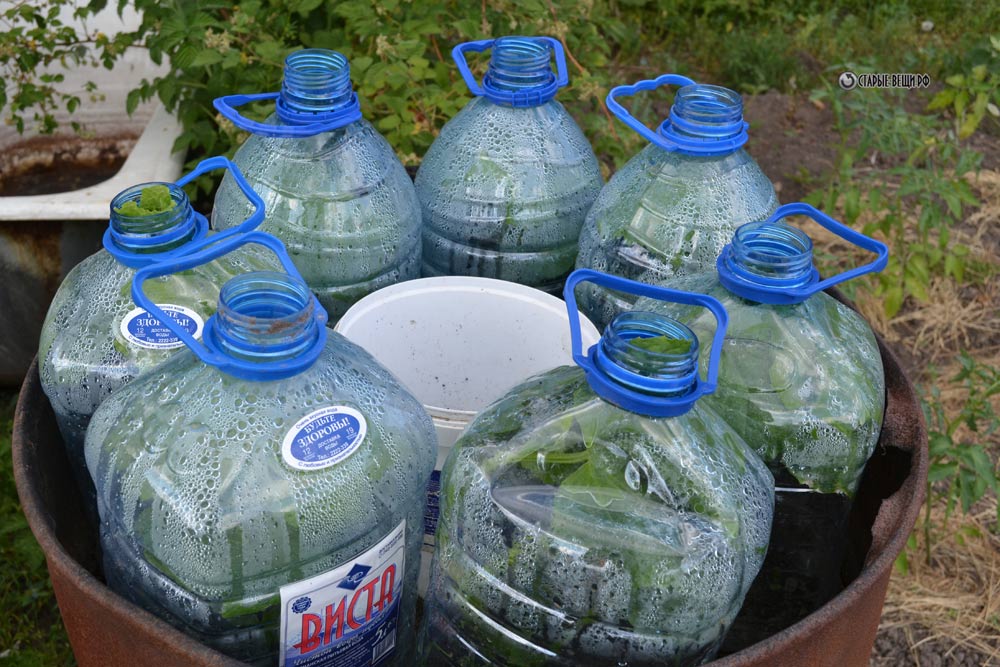 You may be interested in:
You may be interested in:Mistakes in care and their elimination
Cucumbers can be a rather capricious crop, the leaves of which turn yellow and fade due to any violation of the rules of agricultural technology. Even too close proximity to other plants can cause a painful appearance of cucumber bushes.
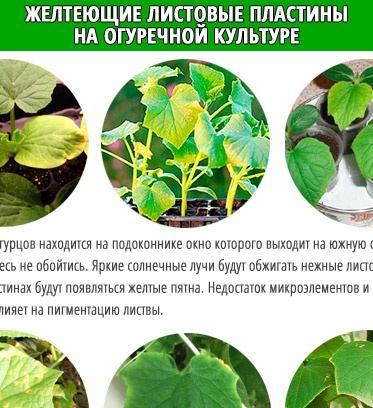
The main causes of yellowing of seedling leaves:
- Use hard and cold water for irrigation. Seedlings must be watered with exclusively warm and “soft” water, which has settled for at least 24 hours.
- Lack of moisture. Regular watering and airing the greenhouse will help solve the problem of yellowing of the leaves.
- Planting seedlings in infertile or depleted soil. Do not plant cucumbers in the same place every year. Increase soil fertility by using regular fertilizers.
- Constant exposure to drafts and sudden changes in temperature. It is worth protecting the plant from uncontrolled gusts of wind, ventilating the greenhouse so that it does not have a draft.
Pests and diseases
Often the cause of yellowing of the leaves are various diseases and pests:
- Most often, seedlings are affected by a fungal disease called powdery mildew. The cause of the appearance of powdery mildew is excessive watering seedlings. You can cope with the disease by treating with systemic fungicides.
- Waterlogging of the soil and watering with cold water can provoke the appearance of root rot. This is a fairly serious disease, which is not always possible to cope with. In case of early detection of the disease, fungicides can be used.
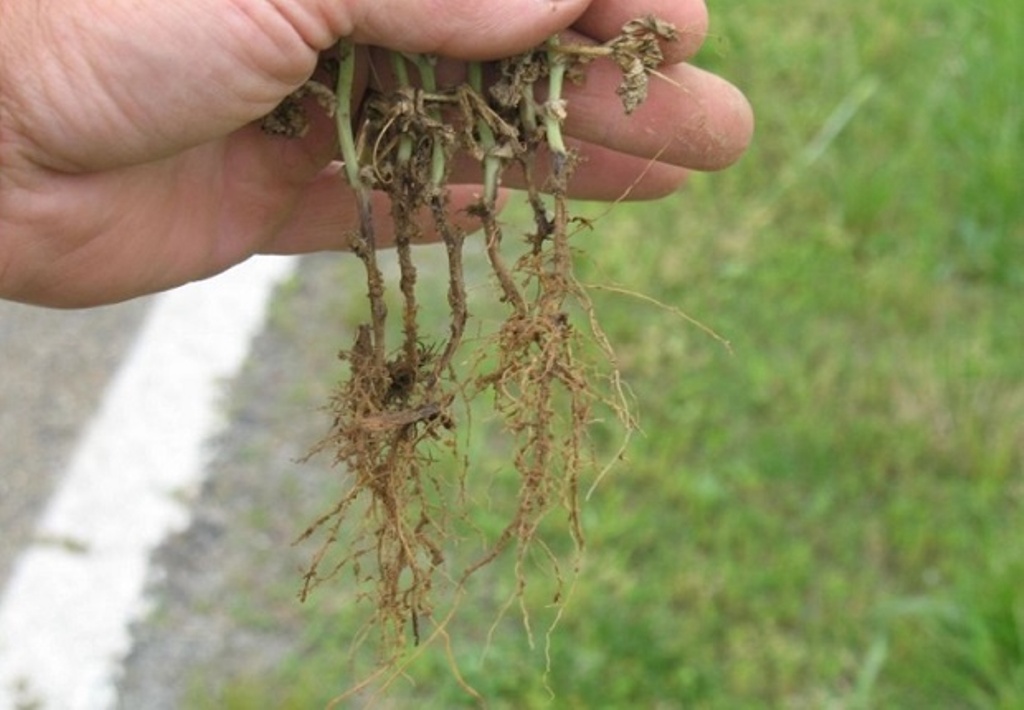
Root rot of cucumbers - Of all kinds of pests, cucumbers are most often affected by a spider mite and a melon aphid. You can get rid of harmful insects by treating the plant with a soap solution or insecticides.
Common Growing Questions
Compliance with all the basic rules of agricultural technology during the sowing of seeds and their proper preparation will help to grow strong seedlings that can easily take root in the greenhouse.

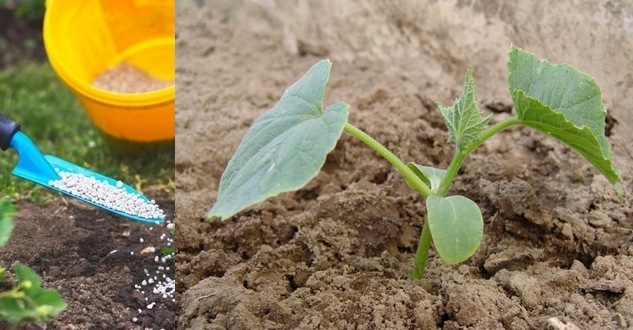
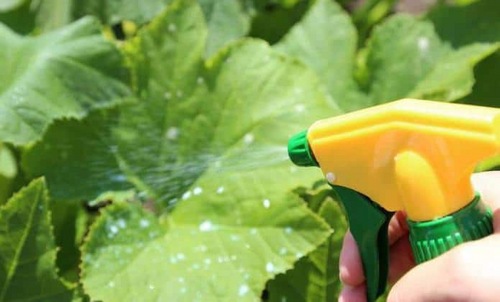
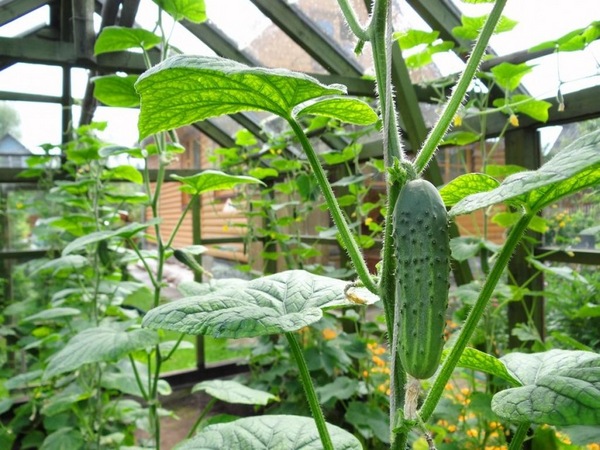
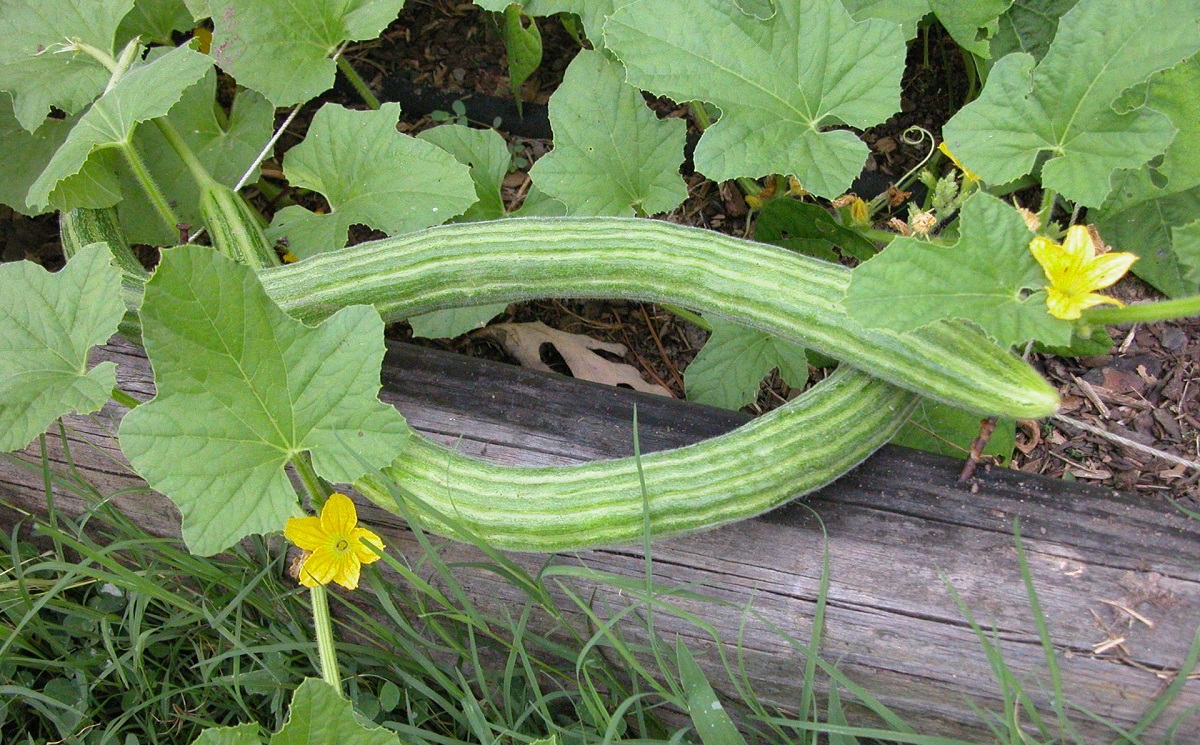 Armenian cucumber with melon flavor: description and characteristics, reviews
Armenian cucumber with melon flavor: description and characteristics, reviews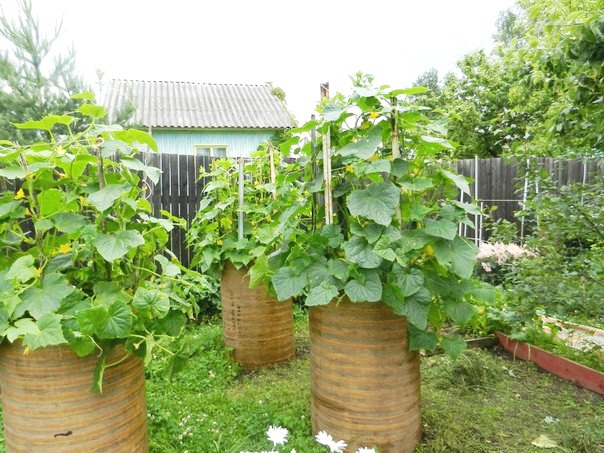 Do-it-yourself vertical beds for cucumbers: schemes, photos
Do-it-yourself vertical beds for cucumbers: schemes, photos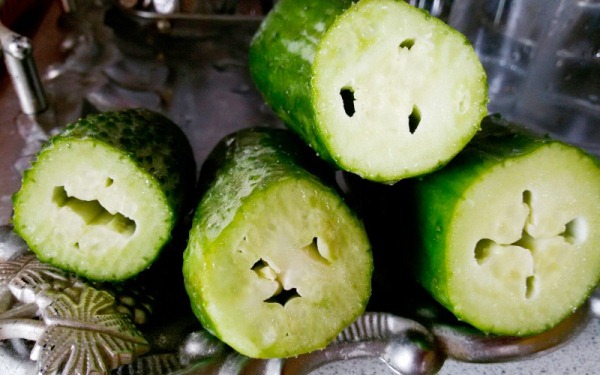 Hollow cucumbers: reasons for the appearance of hollow, what to do
Hollow cucumbers: reasons for the appearance of hollow, what to do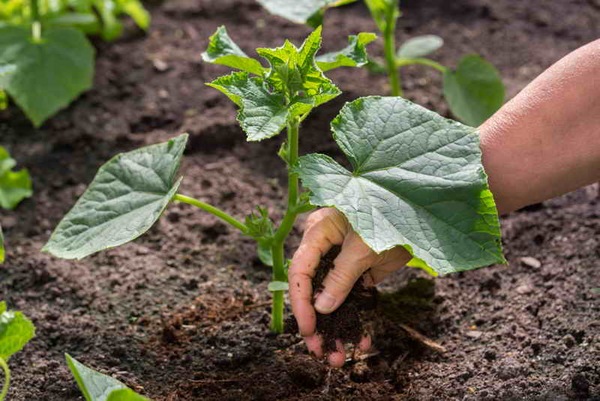 Which manure is best for cucumbers: application, how to breed
Which manure is best for cucumbers: application, how to breed